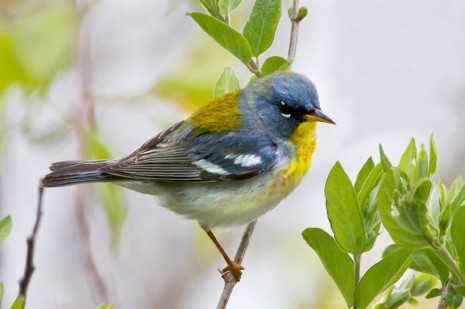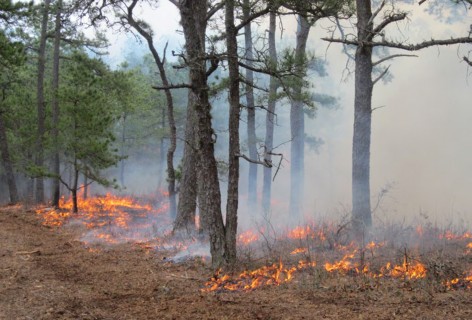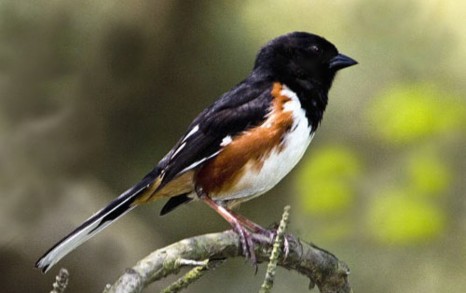Melinda S. LaBranche

Northern Parula may nest in coastal pine barrens. Photograph by Sandy Selesky.
Atlantic coastal pine barrens are distinguished by their fire-mediated climax community that is dominated by pines and often small oaks or other hardwoods. Variously called barrens, savannas, pinelands, flatwoods, sandhills, or sandplains, in their natural state these forests are flat and open with a mild scent of pine and sometimes smoke. The barrens are decidedly rare due to habitat alteration and fire suppression, making them among the “most threatened ecosystems in North America” (King et al. 2011). Coastal pine barrens are actually far from barren, and birders too often ignore these habitats as they drive past or through them to a different birding hot spot.
Historically, regular, naturally occurring fires prevented canopy closure in pine barrens, thereby allowing regeneration of the fire-tolerant pines and associated vegetation. In addition, the regular occurrence of fires reduced the fuel available for future fires, thus promoting faster, cooler burns. With expanding human populations, the barrens’ sandy, dry soil, not ideal for agricultural use, was used for forestry and later residential building (Sohl and Sohl 2012). In areas not already in use, fire suppression allowed tree crowding, canopy closure, and the loss of shrubland plant and animal species. Through recent management efforts, particularly removing non-native pine plantations and regular prescribed burning, pine barrens are slowly returning to a small portion of their historic distribution.

A controlled burn in Mashpee National Wildlife Refuge. Photograph by Catherine J. Hibbard/USFWS. (CC BY 2.0)
In the coastal pine barrens of Massachusetts, pitch pine (Pinus rigida) is the dominant pine species with an understory of scrub oak (Quercus ilicifolia) and dwarf chinquapin (Q. prinoides) (Swain and Kearsley 2001). Griffith et al. (2009) described the New England Atlantic Coastal Pine Barrens ecoregion as transitional between the southern and northeastern coastal zones. The Massachusetts Natural Heritage and Endangered Species Program (NHSEP) divides the local Atlantic pine barrens into two shrub community types and one woodland community (Swain and Kearsley 2001). The two shrub communities, “pitch pine-scrub oak” and “maritime pitch pine on dunes,” are ranked as imperiled and critically imperiled, respectively, in Massachusetts because they have few remaining acres or are vulnerable to extirpation. These shrub communities are mostly limited to Plymouth and Barnstable counties as well as the Montague Wildlife Management Area in Franklin County (Swain and Kearsley 2001). In southeastern Massachusetts, public access is possible at Myles Standish State Forest (MSSF) in Carver and Plymouth; Camps Cachalot and Squanto in Plymouth; the Mashpee Pine Barrens in Mashpee; and the Manuel F. Correllus State Forest on Martha’s Vineyard (Swain and Kearsley 2001). Among the Important Bird Areas that include pine barrens are Dead Neck Island and Mass Audubon’s adjoining Sampsons Island Sanctuary in Osterville; the Massachusetts Military Reservation; and Myles Standish State Forest.
Although pitch pine can grow tall and straight, it also can have a shrubby, crooked habit that decreases its value as lumber (Corey 2007). In New England it was often replaced with plantations of fire-intolerant species such as red pine (P. resinosa) and white pine (P. strobus). Decades of fire suppression promoted by Smokey Bear resulted in a buildup of fuel resulting in hard-to-control, long-burning, tree-killing fires. In 1957 and 1964, fires in Carver that escaped MSSF and leveled nearby homes were among several northeastern fires that eventually brought about major changes in forest management (USFWS 2010). Methods such as logging pine plantations and using prescribed burning to maintain the native vegetation are now used. In some locations, removal of red and white pines has returned the forests to the original native pine barrens. At the Massasoit National Wildlife Refuge, fire is regularly used to manage the pitch pine-scrub oak habitats, however this refuge is not open to the public (USFWS 2010).
In MSSF, red pines—most of them diseased and dying—were removed beginning in February 2014. The foresters’ objectives behind these removals included reducing fire threat and rebuilding the native habitat to sustain numerous rare and endangered species that require open habitats. The species targeted by this management strategy included eastern box turtle (Terrapene carolina) and 15 species of butterflies and moths (Mass DCR 2015), notably the coastal barrens buckmoth (Hemileuca maia) and the large and spectacular imperial moth (Eacles imperialis) (Swain and Kearsley 2001, NHESP 2007). In addition, several rare plants, including broom crowberry (Corema conradii), which require open habitats with frequent fires are known only in these pine habitats (NHESP 2015).
At this point readers may be wondering what all of this has to do with birds. These fire-adapted pine habitats support numerous rare and interesting birds in Massachusetts. Eastern Whip-poor-wills are increasingly restricted to sandy areas in the pine barrens (NHESP 2007) where they nest in scrapes on the ground. Their creamy, marbled eggs blend easily with the light-colored sands (Cink 2002, Brigham et al. 2011) that are opened by fire or by land management that mimics the effects of fire. Discovering the nests or young of whip-poor-wills and other caprimulgids has never been intentional on my part, and was always a result of nearly stepping on the incubating or brooding parent who burst into flight.
Ruffed Grouse, American Woodcock, and Eastern Towhee are all in decline in Massachusetts (Kamm et al. 2013) but can still readily be seen in local pine barrens. Like the caprimulgids, woodcocks nest in a scrape on the ground which their young leave just a few days after hatching. Considered an indicator species for young forests, woodcocks prefer shrub and sapling habitats in pine barrens where their favorite food, earthworms, is prevalent (Masse et al. 2014). Throughout their range, woodcock population declines are thought to be in large part due to loss of the shrublands associated with early succession as forests grow older and canopies close (McAuley et al. 2013). Despite relative stability and even growth in other areas of Massachusetts, the Breeding Bird Atlas 2 (BBA 2) notes that woodcocks are now underrepresented in the southeastern ecoregions (Kamm et al. 2013).

Eastern Towhee. Photography by Sandy Selesky.
The second Breeding Bird Atlas notes that “there is hardly another species that has shown such a dramatic regional shift during the interval between Atlas 1 and 2” than Ruffed Grouse (Kamm et al. 2013). Despite similar percentages of total blocks occupied, the birds appear to be abandoning the eastern half of the state. In fact, the BBA 2 maps show a discernible gap in the area of MSSF. Kamm et al. (2013) suggest this gap may in part be due to forest maturation. Next to a tree or rock and in an open area where they can spot predators, female grouse build a nest on the ground, often lining it with vegetation. The young leave the nest within a day of hatching (Rusch et al. 2000).
Eastern Towhees, the largest and most colorful of our local sparrows, are mostly stable in the southeastern ecoregions despite their slight decline both in Massachusetts (Kamm et al. 2103) and in the United States as a whole (Sauer et al. 2014). Females typically build a cup nest of sticks and leaves on the ground or just above the ground in a tangle of vines (Greenlaw 2015). Threats to towhees include habitat alteration and canopy closure due to late succession (Greenlaw 2015).
Not surprisingly, Pine Warblers are common in pine barrens and are increasing in the state (Kamm et al. 2013). Although rare for most warblers, Pine Warblers regularly eat seeds, including pine seeds (Rodewald et al. 2013). They nest high in pines and are common in the mixed species flocks characteristic of the Southeast in winter (Rodewald et al. 2013). At least once each year in my time in the North Carolina pine savannas, I would observe a Brown-headed Cowbird fledgling that dwarfed the tiny Pine Warbler parent that was feeding it.
The Northern Parula, a species listed as threatened in Massachusetts, is associated with trees covered with dense epiphytic growth. In Massachusetts, the birds are associated with old man’s beard (Usnea sp.) thereby limiting the warblers to habitats that support this lichen, including coastal pine barrens. Female parulas hollow out a hanging nest in the lichens by creating a side entrance and lining the nest cup with more lichens and other soft materials (Moldenhauer and Regelski 2012). Nesting parulas were recorded in Plymouth and Barnstable counties in Massachusetts Breeding Bird Atlas 1 but despite an increase in possible breeding birds in the second atlas they were no longer noted as nesters in Plymouth County (Kamm et al. 2013). The last record for Northern Parula in MSSF recorded in eBird is May 2013.
Other bird species nesting in pine barrens but not confined to this habitat include Wild Turkey, Red-shouldered Hawk, Red-bellied Woodpecker, Eastern Bluebird, Prairie Warbler, and many more.
Many birders are aware of the plights of grasslands and grassland bird species, but the Atlantic coastal pine barrens, with their fire-dependent mid-successional shrub habitats and their associated fauna are equally threatened. To maintain these types of habitats for birds requires management approaches that are complex and can be controversial. Despite the unmistakable benefits of prescribed burning, local communities often are concerned with air quality and the potential for wildfire. Visiting local pine barrens, reporting your sightings, and distributing information about maintaining pitch pine-scrub habitats can go a long way to supporting these ecosystems. Also, for more information about the Southeastern Massachusetts Pine Barrens Alliance in Plymouth visit www.SEMPBA.org.
To see the birds and other species in local pine barrens, I recommend a visit to MSSF, the pine barrens in Mashpee, or those on the Islands. In midsummer, these open communities often make it easy to view even the most secretive species while all other habitats at this season are dense with vegetation. You also may want to visit some of the pitch pine-oak forests that transition between the pine barrens and upland forests throughout southeastern Massachusetts and Cape Cod. Many of these areas include the birds of the shrub pine barrens and are also open to the public, including parts of the Cape Cod National Seashore, Wellfleet Bay Wildlife Sanctuary, and a number of parks and natural areas owned by Plymouth, Carver, Wareham, Barnstable, Sandwich, and other nearby towns in Plymouth County and Cape Cod.
References
- Brigham, R. M., J. Ng, R. G. Poulin, and S. D. Grindal. 2011. Common Nighthawk (Chordeiles minor) in The Birds of North America Online (A. Poole, Ed.). Ithaca: Cornell Lab of Ornithology.
- Cink, C. L. 2002. Eastern Whip-poor-will (Antrostomus vociferus) in The Birds of North America Online (A. Poole, Ed.). Ithaca: Cornell Lab of Ornithology.
- Greenlaw, J. S. 2015. Eastern Towhee (Pipilo erythrophthalmus) in The Birds of North America Online (A. Poole, Ed.). Ithaca: Cornell Lab of Ornithology.
- Griffith, G. E., J. M. Omernik, S. A. Bryce, J. Royte, W. D. Hoar, J. W. Homer, D. Keirstead, K. J. Metzler, and G. Hellyer. 2009. Ecoregions of New England. Reston, Virginia: United States Geological Survey.
- Gucker, Corey L. 2007. Pinus rigida. In: Fire Effects Information System, [Online]. U.S. Department of Agriculture, Forest Service, Rocky Mountain Research Station, Fire Sciences Laboratory (Producer). Accessed June 3, 2016.
- Kamm, M. J. Walsh, J. Galluzzo and W. Petersen. 2013. Massachusetts Breeding Bird Atlas 2. Scott and Nix: New York.
- King, D. I., S. Schlossberg, R. T. Brooks, M. E. Akresh. 2011. Effects of fuel reduction on birds in pitch pine-scrub oak barrens of the United States. Forest Ecology and Management 261:10–18.
- Massachusetts DCR. 2015. Pine Barrens Restoration Timber Harvest. Accessed June 2, 2016.
- McAuley, D., D. M. Keppie, and R. M Whiting, Jr. 2013. American Woodcock (Scolopax minor) in The Birds of North America Online (A. Poole, Ed.). Ithaca: Cornell Lab of Ornithology.
- Moldenhauer, R. R. and D. J. Regelski. 2012. Northern Parula (Setophaga americana) in The Birds of North America Online (A. Poole, Ed.). Ithaca: Cornell Lab of Ornithology.
- NHESP. 2007. Natural Community Fact Sheet: Pitch Pine/Scrub Oak Communities. Natural Heritage and Endangered Species Program, Massachusetts Division of Fisheries & Wildlife. Westborough, MA.
- NHESP. 2013. Priority Types of Natural Communities. Natural Heritage and Endangered Species Program, Massachusetts Division of Fisheries & Wildlife. Westborough, MA.
- NHESP. 2015. Broom Crowberry: Corema conradii (Torr.)Torr. ex Loudon. Natural Heritage and Endangered Species Program, Massachusetts Division of Fisheries & Wildlife. Westborough, MA.
- Rodewald, P. G., J. H. Withgott, and K. G. Smith. 2013. Pine Warbler (Setophaga pinus) in The Birds of North America Online (A. Poole, Ed.). Ithaca: Cornell Lab of Ornithology.
- Rusch, D. H., S. Destefano, M. C. Reynolds, and D. Lauten. 2000. Ruffed Grouse (Bonasa umbellus) in The Birds of North America Online (A. Poole, Ed.). Ithaca: Cornell Lab of Ornithology.
- Sauer, J. R., J. E. Hines, J. E. Fallon, K. L. Pardieck, D. J. Ziolkowski, Jr., and W. A. Link. 2014. The North American Breeding Bird Survey, Results and Analysis 1966 - 2013. Version 01.30.2015. USGS Patuxent Wildlife Research Center, Laurel, MD.
- Swain, P. C. and J. B. Kearsley. 2001. Classification of the Natural Communities of Massachusetts. Version 1.3. Westborough, MA: Natural Heritage and Endangered Species Program, Division of Fisheries & Wildlife.
- Sohl, T. L. and L. B. Sohl. 2012. Land–Use Change in the Atlantic Coastal Pine Barrens Ecoregion. The Geographical Review 102: 180 – 201.
- USFWS. 2010. Massasoit National Wildlife Refuge: Burning to Protect Wildlife and People. Eastern Massachusetts National Wildlife Refuge Complex, Sudbury, MA.
- Walker, J. W. and R. K. Peet. 1984. Composition and species diversity of pine - wiregrass savannas of the Green Swamp, North Carolina. Vegetatio 55: 163-179.
Melinda S. (Mindy) LaBranche is an adjunct professor of biology at Bridgewater State University and a copy editor for Bird Observer. She learned to love pine barrens while growing up on Cape Cod and during her graduate work studying Red-cockaded Woodpeckers in the pine savannas of North Carolina. Mindy is on the board of the Rochester Land Trust, and invites you to visit its trails and find some of the plants and animals mentioned here.